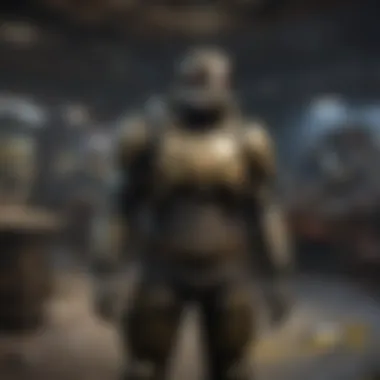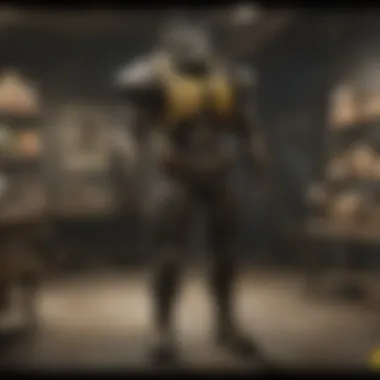Exploring the Fallout 76 Item Shop: Impact and Insights


Intro
The Fallout 76 item shop serves as a critical component of the gaming experience within the broader Fallout universe. This analysis explores various facets of the item shop, shedding light on its items, impact on gameplay, and related economic considerations. Each aspect intertwines with player experiences, making it essential for both veterans and newcomers to understand.
Lore Insights
Overview of the Fallout Universe
The Fallout series is set in an alternate future marked by nuclear devastation. Players navigate a world filled with remnants of pre-war civilization, mutated creatures, and various factions vying for power and resources. Fallout 76, the series' first entirely online installment, introduces players to the wasteland of West Virginia, integrating multiplayer elements while preserving the franchise's core storytelling.
Key Historical Events in the Fallout Timeline
Several pivotal events shape the Fallout universe. The Great War, a catastrophic nuclear conflict, marks the timeline's major turning point. This event devastated the planet and established the post-apocalyptic backdrop for all entries in the series. Subsequent reactions to the war, such as the formation of different factions and the establishment of Vaults, create a complex narrative atmosphere.
Major Factions and Characters
In Fallout 76, factions play an essential role. Players can interact with groups like the Brotherhood of Steel or the Responders, each embodying different ideologies and motivations. Understanding these factions adds depth to the gameplay experience, allowing players to align themselves with different groups or maintain a neutral stance.
Gameplay Tips and Strategies
Beginner's Guide to Playing Fallout Games
For newcomers, starting in Fallout 76 can feel overwhelming. Players should familiarize themselves with the user interface and basic gameplay mechanics. Engaging in the main questline and participating in events are great ways to start. Exploring the map and gathering resources promotes a better understanding of the environment.
Weapon and Armor Recommendations
Equipping the right gear is critical for survival in the wasteland. Players should consider using weapons like the Pipe Pistol early on, which is reasonably powerful for beginners. As they progress, firearms like the Assault Rifle or powerful melee weapons can enhance combat efficiency. Armor sets improving damage resistance, such as Leather Armor, are also advisable.
Tips for Efficient Resource Management
Managing resources effectively is vital. Players can prioritize gathering caps, crafting materials, and consumables. Utilizing the Camp feature enables players to construct shelters and manage resources more effectively. This minimizes waste and maximizes efficiency, allowing for better preparedness against enemies.
Economic Implications
The Fallout 76 item shop introduces a microtransaction model that has stirred discussions within the gaming community. Players can purchase various items, including cosmetic upgrades and crafting materials. This approach has economic implications, encouraging debates over fairness and accessibility.
"Microtransactions can enhance the experience for some, while frustrating others who prefer traditional gameplay methods."
Community Opinions
Reception of the item shop varies significantly across the community. Some players appreciate having additional options and customization, while others feel that it undermines the integrity of the game. The balance between monetization and playability remains a hot topic in discussions on platforms like Reddit.
Closure
In summary, understanding the Fallout 76 item shop requires a broader insight into both the game’s mechanics and the surrounding community dynamics. This exploration emphasizes that the item shop is not merely about transactions, but rather about how it has influenced player experiences, community reactions and the ongoing evolution of the Fallout franchise.
Prolusion to Fallout Item Shop
The Fallout 76 Item Shop represents a significant aspect of the gaming experience within the expansive world of Fallout. Understanding this element is crucial for both players and observers of the gaming industry, as it reflects broader trends in monetization and player engagement. This section will delve into the fundamental components of the Item Shop, its purpose, and its relevance in the current gaming landscape.
Overview of Fallout
Fallout 76 is an online multiplayer role-playing game developed by Bethesda Game Studios. Released in November 2018, the game is part of the well-known Fallout franchise, which is set in a post-apocalyptic world, filled with rich lore, exploration, and survival elements. Unlike previous installments, Fallout 76 opens the doors for players to explore West Virginia together in a shared world. The game emphasizes survival mechanics, requiring players to gather resources, build shelters, and face various enemies. Given this context, the Item Shop becomes a critical tool for enhancing the gameplay experience by offering additional options.


Purpose of the Item Shop
The primary purpose of the Fallout 76 Item Shop is to provide players access to a diverse array of in-game items that enhance their gaming experience and allow for a degree of customization. This shop offers cosmetic items, utility enhancements, and features tied to limited events. Players can acquire these items using real-world money or in-game currency, depending on the specific offerings and promotions.
Moreover, the Item Shop addresses several needs for players, including:
- Customization: Players can personalize their characters and camps with various cosmetic options, such as outfits, skins, and décor.
- Convenience: Access to utility items can streamline gameplay, making certain tasks easier and enhancing survivability.
- Engagement: Seasonal events and exclusive items can keep the community engaged and invested in the game, encouraging players to return and explore new content.
Item Types Available
Understanding item types available in the Fallout 76 Item Shop is essential. The array of items provides insight into the game’s direction and player priorities. Players engage with these different categories for various reasons, ranging from aesthetic enhancements to gameplay advantages. Each category serves distinct purposes, establishing a diversified in-game economy. The following sections delve deeper into the specifics of each type.
Cosmetic Items
Cosmetic items in Fallout 76 primarily enhance appearance without altering gameplay mechanics. These include character skins, outfits, and camp decor. They allow personal expression and identity in a post-apocalyptic world. For many players, customizing a character’s look becomes a form of self-expression, fostering a connection to the game.
Moreover, these items often come with seasonal themes or unique designs that may capture player interest, encouraging purchases. Although they do not directly impact gameplay, they significantly enhance player engagement. Some players might say that these items contribute to territorial identity when building camps, serving as a form of social currency among players. In this sense, cosmetic items may hold intrinsic value beyond mere aesthetics.
Utility Items
Utility items serve practical purposes, often aimed at improving the overall gameplay experience. This includes crafting materials, storage options, and consumables that assist in survival. Players may rely on these items during intense battles or resource shortages, making them vital for successful gameplay.
Access to certain utility items might encourage players to spend real money to obtain them more quickly. For instance, subscription models like Fallout 1st offer exclusive utility items that can affect performance in the game. This practice creates a debate within the community regarding fairness and balance. Ultimately, the utility items available in the shop have a significant impact on how players experience challenges and support gameplay progression.
Seasonal and Event Items
Seasonal and event items are tied to specific periods in the game calendar, reflecting real-world festivities and in-game events. These items often include exclusive skins, limited-time decorations, and special consumables, creating unique themes within the game environment. Such items may instigate a sense of urgency, compelling players to make timely purchases to acquire them.
These limited-time offerings can foster a community feeling as players engage in similar activities during events. They also serve a marketing function, promoting continued engagement with the game throughout the year. The presence of these items demonstrates the continual evolution of the game and its ability to adapt to player interests. While they may only be available for a short time, their impact on player behavior can be long-lasting.
Seasonal and event items unit players through shared experiences, contributing to a dynamic gameplay atmosphere.
Economic Model of the Item Shop
Understanding the economic model of the item shop in Fallout 76 is crucial for both players and developers. It lays the groundwork for how in-game items are monetized, affecting player interactions, community feelings, and overall game integrity. At its core, this model utilizes microtransactions to allow players to purchase various items ranging from cosmetics to utility enhancements. Moreover, this system raises important questions about balance, fairness, and the potential influence on the game's economy.
Microtransactions Explained
Microtransactions are small financial transactions that players can make to purchase virtual goods. In Fallout 76, these transactions are typically completed through real money exchanged for atoms, the in-game currency. Players can use these atoms to buy skins, emotes, and other cosmetic items, which do not directly impact gameplay. The appeal of microtransactions lies in their convenience, allowing players to customize their characters without extensive grinding. However, reliance on microtransactions can often lead to concerns about the value of time spent playing the game versus money spent in the item shop.
Some players argue that such a model can encourage a “pay-to-win” environment, even when the items available do not offer gameplay advantages. The psychologically alluring nature of microtransactions may result in compulsive spending, further complicating the issue. Maintaining a balance between enticing offerings and keeping the game equitable is thus a pressing challenge for developers, who frequently receive feedback regarding both the quantity and the pricing of items available in the shop.
Impact on In-Game Economy
The implementation of an item shop has significant implications for the in-game economy of Fallout 76. By introducing a system where players can spend real money for in-game items, developers must consider how this affects resource distribution, player behavior, and overall game health.
- Resource Inflation: The availability of direct purchases can lead to inflation of in-game resources. Players might expect certain items or advantages simply due to their monetary value, which disrupts the balance that would typically be achieved through gameplay.
- Player Engagement: The item shop can also influence player engagement. Some might spend more time in the game to accumulate atoms, leading to increased gameplay time, while others may choose to spend money instead, affecting how they interact with the game environment.
- Market Dynamics: The introduction of purchasable items could alter how players perceive item rarity and value within the game itself. This shift in mindset can lead to changes in trading and lending behavior, thereby altering the social dynamics within the game.
Player Engagement with the Item Shop
Understanding player engagement with the item shop is crucial for analyzing its role in the overall perception of Fallout 76. This part discusses how players interact with the shop, their motivations behind purchases, and the implications of their engagement on the community and gameplay.
Purchasing Behavior of Players


Player purchasing behavior in Fallout 76's item shop reflects broader trends in consumer habits within gaming. Players often weigh the benefits of acquiring cosmetic or utility items against their in-game experience. Recent surveys indicate that many players spend funds on aesthetic upgrades, like skins or outfits, rather than on items that change gameplay dynamics.
This trend suggests a desire for personal expression in a shared digital space. Players aim to showcase styles unique to their characters, fostering a sense of identity within the wasteland.
However, players also exhibit restraint. Some choose to wait for discounts or significant updates before making purchases. Others argue that microtransactions should not disrupt the balance of the game. This creates a mixed environment where enthusiasm coexists with skepticism. Understanding these patterns helps in gauging the shop's acceptance and its effect on the community.
Community Reactions
The community’s reaction to the item shop provides insight into its impact on player morale and loyalty. Feedback varies widely. Many players appreciate the range of optional items that allows customization without altering core gameplay mechanics. On forums, there is a sentiment that the item shop has added aesthetic value to the game.
Conversely, critiques surface regarding the commercial aspect of microtransactions. Some players argue that the pricing model may harm the experience, suggesting it prioritizes profit over player engagement. Criticism often appears in discussions on platforms like Reddit and Facebook, where the community voices concerns about fairness and the potential for pay-to-win mechanics.
Notably, the developer's responsiveness to these critiques influences community trust. Transparent communication about future changes can enhance positive engagement, while neglect can lead to frustration.
"The item shop is fine as long as it doesn't undermine the gameplay experience. Many players just want new visual items without feeling obligated to spend money."
Ultimately, community engagement with the item shop forms an integral part of the Fallout experience. It highlights a balance between personal choice and community standards.
The continuing evolution of player engagement with the item shop will define its relevance in the future of Fallout 76.
Critique of the Item Shop System
The Fallout 76 item shop deserves a critical evaluation, as it directly influences player satisfaction and overall game perception. Understanding the facets of this system helps identify strengths and weaknesses that both the developers and players must address. This critique focuses on how the item shop operates within the game's economy, discusses the implications of its availability, and examines community feedback.
Pros and Cons
The item shop provides specific advantages and disadvantages that affect player interaction and engagement.
Pros:
- Accessibility to Cosmetics: Players have the chance to personalize their characters through various cosmetic items without extensive grind. This allows for a more unique player experience.
- Funding for Game Development: The revenue from microtransactions contributes to updates and expansions, thus enhancing overall gameplay by providing developers with necessary funds.
- In-Game Events Support: Seasonal and limited-time items create excitement among the community, encouraging participation in events.
Cons:
- Pay-to-Win Perceptions: Some items may give competitive advantages, leading to feelings of unfairness among players who do not purchase them.
- Monetization vs. Gameplay Experience: The presence of a monetized store can shift focus from game immersion to financial transactions, potentially detracting from the overall enjoyment.
- Community Divisions: Discussions around the item shop often lead to polarized opinions within the player base, which can create rifts among players.
"A balanced review of any item shop is essential to understanding how it affects the integrity of a game and its community."
Balancing Fun and Commercial Interests
Striking the right balance between player enjoyment and the commercial viability of the item shop is a central challenge. Developers must ensure that while they aim to monetize the game, they do not alienate their player base.
One effective approach is to ensure that items do not alter fundamental gameplay mechanics but instead enhance the visual and social aspects of the game. For instance, many cosmetics could be available without disrupting the current economic system or gameplay balance.
Moreover, providing players with alternative ways to earn currency for shops can foster a sense of fairness. This could include in-game challenges or rewards, which would allow players who do not wish to spend real money to still engage meaningfully with the shop offerings.
The item shop's design should prioritize player satisfaction while maintaining economic sustainability, ensuring that it positively contributes to the Fallout experience.
Comparisons with Other Games
The importance of comparing the Fallout 76 Item Shop with similar systems in other games is multi-faceted. Such comparisons can shed light on the effectiveness and player reception of the item shop's features, as well as its impact on gameplay and community dynamics. By examining the trends and strategies of various titles, insights emerge that reveal both the strengths and weaknesses of Fallout 76’s approach to in-game monetization. This scrutiny also places the Fallout 76 Item Shop within a broader context of the gaming industry, facilitating a deeper understanding of its standing among players and developers alike.
Trends in the Industry


The gaming industry has seen significant shifts in how microtransactions are integrated into gameplay. Trends include an increasing reliance on cosmetics and non-pay-to-win elements. Games like Fortnite have successfully monetized their items without disrupting gameplay balance, while others have elected to offer gameplay advantages through purchases.
In contrast, Fallout 76 has largely focused on cosmetic enhancements and utility items. This reflects a broader trend towards ensuring that in-game purchases do not alienate players who prefer free-to-play experiences. This model encourages more player engagement while helping to maintain a balanced gaming environment. The implementation of seasonal events and special promotions draws in players, allowing a consistent influx of fresh content that aligns with this trend.
Some key industry trends include:
- Increased focus on cosmetic items that do not impact gameplay.
- Use of limited-time events to encourage purchases.
- Community-driven content, reflecting player desires and feedback.
- Promoting cross-platform compatibility to maximize player interaction.
Learning from Competitors
Looking at other successful titles highlights valuable lessons that Fallout 76 can adopt to improve its item shop system. Games like Apex Legends and Destiny 2 have built thriving communities partly due to their approaches to in-game shops. They emphasize player engagement, transparency in pricing, and meaningful rewards, driving continuous interest in in-game purchases.
Key takeaways for Fallout 76 could include:
- Enhancing transparency in pricing and item availability to foster player trust.
- Incorporating community feedback into item offerings, ensuring that players feel heard.
- Adding more exclusive items or rewards for long-term players, which can strengthen loyalty.
- Regular updates and features can keep the shop dynamic and appealing.
"Understanding competitors’ successes can guide Fallout 76 to refine its item shop, aligning itself with player expectations and industry standards."
These comparisons indicate that implementing lessons from other gaming models can enrich the Fallout 76 item shop, making it a more integral part of the player experience.
Future of the Item Shop
The discussion around the future of the Fallout 76 item shop is crucial. This topic encapsulates various aspects that can shape the game environment and player experience. As Bethesda continues to develop this platform, understanding possible changes is key for the community. Players are interested in how new updates might cater to their needs while aligning with business interests. This section dives deep into potential updates and the long-term consequences of these decisions.
Possible Updates and Changes
As we look ahead, there are several potential updates and changes anticipated for the Fallout 76 item shop. These updates may include:
- New Cosmetic Items: Players often desire fresh content. Regularly adding new skins, costumes, and decorations can retain interest.
- Enhanced Functionality: Improving the navigation and usability of the shop itself might enhance user experience. Simpler systems make for smoother transactions.
- In-Game Events: Tying item releases to specific in-game events can help create excitement. This engages players who enjoy special themed items.
- Pricing Adjustments: Re-evaluating the cost of items and possibly introducing sales or bundles may entice spending without alienating players.
- Feedback Mechanisms: Implementing ways for players to offer feedback on items could improve future offerings. Listening to community input can help developers tailor the shop to better fit desires.
"The success of a game’s item shop largely depends on its ability to adapt to community sentiment while ensuring a profitable model".
These potential updates indicate that there is room for growth and evolution in the shop's mechanisms, aligning product offering with player interests and game dynamics.
Long-Term Impact on the Gameplay Experience
The changes in the item shop do not just affect purchasing; they also influence the overall gameplay experience. As the shop evolves, players will likely feel the impact in several key areas:
- Player Retention: Frequent updates can boost player retention. Engaged players often return to see what new content awaits them. This ongoing engagement can enhance community building.
- Game Balance: Introducing items can affect gameplay mechanics. For example, some items might offer advantages. Developers will need to consider how to keep competitive balance intact.
- Community Dynamics: How players interact can shift based on the item shop. Exclusive or limited-time items might create a rush, leading to different social interactions among players.
- Monetization Perception: Changes can affect how players perceive the monetization strategy. If updates align with community interests, it can build a more positive image.
The long-term consequences could either foster a rich and engaging gameplay environment or lead to player frustration, based on how developments are handled. Addressing community feedback can mitigate potential negative effects.
In summary, the future direction of the Fallout 76 item shop hinges on thoughtful updates and a keen awareness of player experiences, ensuring that it remains relevant and engaging.
The End
In this exploration of the Fallout 76 item shop, we delve into aspects that shape not only the player experience but also the economic landscape within the game. The importance of the item shop cannot be overstated. This section synthesizes the critical points discussed throughout this article, providing a comprehensive understanding of how the shop operates and its broader implications on gameplay.
Summarizing Key Points
The Fallout 76 item shop serves several significant functions. First, it provides players with access to a variety of items, enhancing personalization and engagement. Players can acquire cosmetic and utility items that allow for a richer gaming experience. The connection between microtransactions and game enjoyment is particularly noteworthy.
Another key point is the economic model employed by the shop. Microtransactions are at the heart of this model, leading to discussions about their effects on the game’s overall economy. This has prompted varied reactions from the community, showcasing the complexities and nuances involved.
Moreover, the future of the item shop raises important questions about potential changes and their long-term impacts on player experience. As the game continues to evolve, understanding these dynamics is essential for both players and developers.
Final Thoughts on Player and Developer Dynamics
The relationship between players and developers regarding the item shop highlights a broader trend in the gaming industry. Unlike traditional models, the reliance on in-game purchases adds layers to player interaction and developer strategies. Balancing player satisfaction with revenue generation is a delicate dance that influences decisions at every level.
Feedback from the community reveals various sentiments towards the item shop's structure and offerings. Developers now find themselves in a position where listening to player feedback is paramount. Adapting to these responses could dictate the future stability and success of the Fallout 76 ecosystem.







